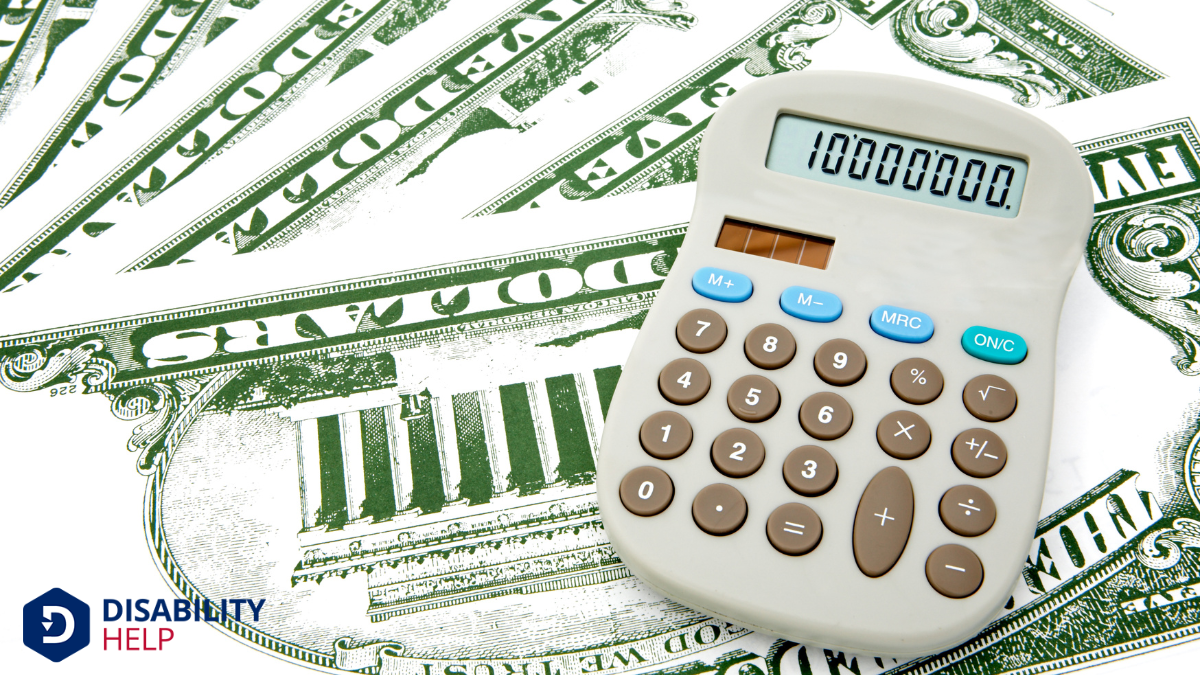Calculating your potential disability benefitsFinancial assistance provided to individuals who are unable to work due to a disability, such as Soc... can feel overwhelming, but breaking it down step-by-step makes it manageable. Start by examining your work history and earnings, which are essential for determining your Average Indexed Monthly Earnings (AIME). Once you have that, you can work towards estimating your Primary Insurance Amount (PIA). But there's more to take into account, like adjustments and other income factors. Curious about how these elements fit together? Let's explore further.
Key Takeaways
- Review your Social Security Statement for accurate work history and earnings records on the Social Security Administration's website.
- Calculate your Average Indexed Monthly Earnings (AIME) using your highest 35 earning years, adjusted for inflation.
- Determine your Primary Insurance Amount (PIA) by applying Social Security's bend points to your AIME.
- Consider family benefits, including eligibility for spouses and children, subject to family maximum limits.
- Use online Social Security calculators to estimate potential disability benefits based on personal data.
Understanding the Different Types of Disability Benefits
When exploring disability benefits, it's important to understand the different types available to you.
Primarily, there are two main programs: Social Security Disability Insurance (SSDI)A U.S. government program that provides financial assistance to individuals who are unable to work d... and Supplemental Security Income (SSI).
SSDI is for individuals who've worked and paid Social Security taxes, providing benefits based on their earnings record. On the other hand, SSI is a needs-based program for those with limited income and resources, regardless of work history.
Both programs aim to support you financially if you're unable to work due to a disability. Eligibility for each depends on specific criteria, and knowing which one fits your situation will help you apply correctly.
Understanding these distinctions guarantees you’re on the right path to receiving the support you need.
Gathering Your Work History and Earnings Information

To kick off the process of calculating your disability benefits, start by obtaining your Social Security Statement.
This statement is essential as it allows you to review your earnings record and guarantees that everything is accurate.
Don't forget to verify your work credits, as they play a key role in determining your eligibility for benefits.
Obtain Social Security Statement
Understanding your Social Security Statement is vital for gathering your work history and earnings information. To obtain it, visit the Social Security Administration's website and create a "my Social Security" account. This online portal is user-friendly and provides easy access to your Statement.
Once logged in, locate the section dedicated to your earnings history. This document outlines your annual earnings and the Social Security taxes you've paid over the years. It's a significant step in calculating your potential disability benefits.
If online access isn't convenient, request a paper statement by contacting the Social Security Administration directly. Having this information at your fingertips guarantees you're well-prepared to assess how much disability you may qualify for based on your past work.
Review Earnings Record
After obtaining your Social Security Statement, the next step is to review your earnings record carefully. This record is vital because your disability benefits are based on your work history and earnings.
Start by verifying all your work years are listed correctly. Mistakes can impact your benefit calculation considerably. Pay attention to:
- Accuracy of Earnings: Check that your reported earnings match your actual income each year.
- Missing Years: Verify there are no missing years, which could lower the calculated benefits.
- Correct Employers: Confirm that all employers you've worked for are included in the record.
Spotting errors early can save you time and frustration later. If you find discrepancies, gather any relevant documentation to correct them promptly.
This step is fundamental for calculating accurate disability benefits.
Verify Work Credits
Before diving into your disability benefits calculation, ensuring you have the necessary work credits is essential. Work credits are based on your total yearly wages or self-employment income.
In 2023, you earn one credit for every $1,640 in wages, up to four credits per year. To qualify for Social Security Disability InsuranceA form of insurance that provides income to individuals who are unable to work due to a disability. (SSDI), you typically need 40 credits, with 20 earned in the last 10 years.
To verify your work credits, gather your work history and earnings information. Access your Social Security Statement online through your my Social Security account. This document outlines your earnings and the number of work credits you’ve accumulated.
If discrepancies arise, contact the Social Security Administration to correct them, ensuring your eligibility for benefits.
Calculating Your Average Indexed Monthly Earnings (AIME)
To determine your Average Indexed Monthly Earnings (AIME), you'll need to grasp the concept of how Social Security calculates your benefits. AIME is vital because it forms the basis for your disability payments.
You'll start by looking at your lifetime earnings and adjusting them for inflation. This process guarantees that your past earnings reflect current economic conditions.
Here's how you can calculate it step-by-step:
- Identify your highest-earning years: Social Security typically considers up to 35 years of your highest earnings.
- Index your earnings: Adjust these earnings for inflation using Social Security's indexing factors.
- Calculate the average: Divide the total of your indexed earnings by the number of months in those years.
Understanding your AIME is essential for anticipating your disability benefits accurately.
Determining Your Primary Insurance Amount (PIA)
With your Average Indexed Monthly Earnings (AIME) in hand, you’re ready to determine your Primary Insurance Amount (PIA), the figure that directly influences your disability benefits.
To calculate your PIA, apply the Social Security Administration’s (SSA) bend points to your AIME. These bend points, which change yearly, segment your earnings into three portions.
First, take 90% of the initial portion, followed by 32% of the next portion. Finally, apply 15% to any remaining amount.
Add these three results together to find your PIA. This calculated amount represents the monthly benefit you’d receive if you were eligible for disability benefits at full retirement age.
Considering Additional Factors That May Affect Your Benefits

When calculating your disability benefits, don't forget to factor in cost-of-living adjustments, which can increase your monthly payments over time.
It's also important to contemplate any other income sources you have, as these might affect the amount you receive.
Additionally, if you have eligible family members, they may be entitled to benefits based on your work record, which can impact your overall financial planning.
Cost-of-Living Adjustments
While understanding how disability benefits work, it’s essential to take into account Cost-of-Living Adjustments (COLAs), which can influence the amount you receive.
COLAs are annual increases designed to counteract inflation, ensuring that your benefits maintain their purchasing power. They’re based on the Consumer Price Index (CPI), reflecting changes in the cost of goods and services.
Here’s how COLAs can affect your benefits:
- Annual Adjustments: Each year, your benefits may increase, keeping pace with the cost of living.
- Inflation Protection: Helps you avoid financial strain as living costs rise, maintaining your standard of living.
- Automatic Increases: You don't need to apply for COLAs; they're automatically applied to your benefits.
Understanding these adjustments helps you plan your finances effectively.
Other Income Sources
As you consider how COLAs influence your disability benefits, it's equally important to examine other income sources that might affect your benefit amount. Some income types, like wages from a part-time job, can impact the benefits you receive.
If you earn above the substantial gainful activity (SGA) threshold, your benefits might be reduced. Additionally, other disability payments, such as workers' compensation or certain public disability benefits, could lower your Social Security Disability Insurance (SSDI) payments.
It's essential to report all income accurately to guarantee your benefits are calculated correctly. Remember, not all income affects your benefits. For instance, Supplemental Security Income (SSI) includes some exclusions, like a portion of earned income, so understanding the rules can help you manage your finances effectively.
Family Member Benefits
Although maneuvering disability benefits can seem complex, understanding how family member benefits work can simplify things. If you're eligible for Social Security Disability Insurance (SSDI), your family members might also qualify for additional benefits. These benefits can provide essential financial support to your household.
To determine eligibility and potential amounts, consider these key factors:
- Relationship to You: Benefits often extend to spouses, minor children, and sometimes adult children who are disabled.
- Benefit Limits: There’s a family maximum limit, typically between 150-180% of your disability benefit, which caps the total amount payable to your family.
- Family Member’s Own Earnings: If a family member earns their own income, it might reduce their eligibility for benefits.
Utilizing Online Tools and Resources for Estimation
When traversing the complex world of disability benefits, many find online tools and resources invaluable for estimating potential support. These tools simplify calculations by allowing you to input personal data, such as your average earnings and work history, to provide a reliable estimate.
Websites like the Social Security Administration offer calculators specifically designed for this purpose. You’ll gain insight into your potential benefits without the hassle of manual calculations.
To get started, gather your employment records and details about your earnings. Input this information into the calculator, and it’ll provide an estimation of your monthly benefits.
Don’t overlook FAQs and tutorials often available on these sites, as they can clarify any doubts and guide you through the process with ease.
Conclusion
To wrap it up, calculating your disability benefits involves understanding your work history, earnings, and applying Social Security's formulas. Start by gathering your Social Security Statement to assess your highest-earning years. Calculate your Average Indexed Monthly Earnings (AIME) and use the bend points to determine your Primary Insurance Amount (PIA). Don't forget to factor in Cost-of-Living Adjustments (COLAs) and any additional income. For a quick estimate, use online tools and resources to simplify the process.






